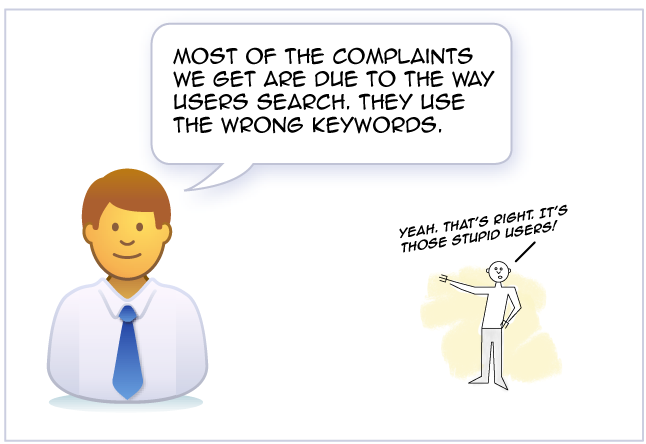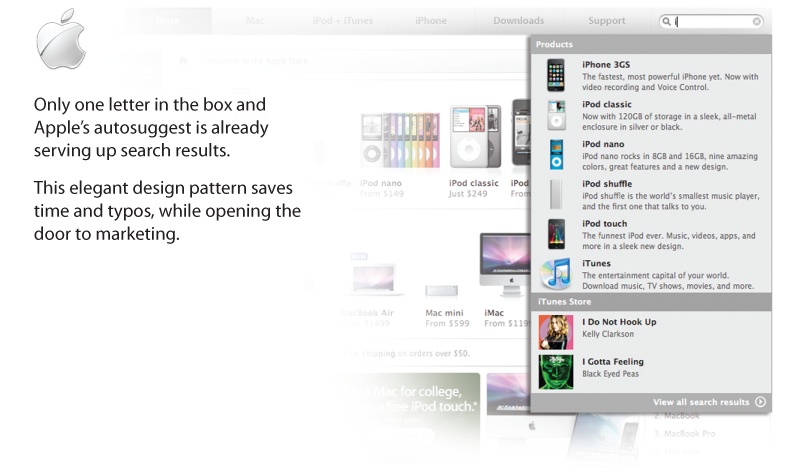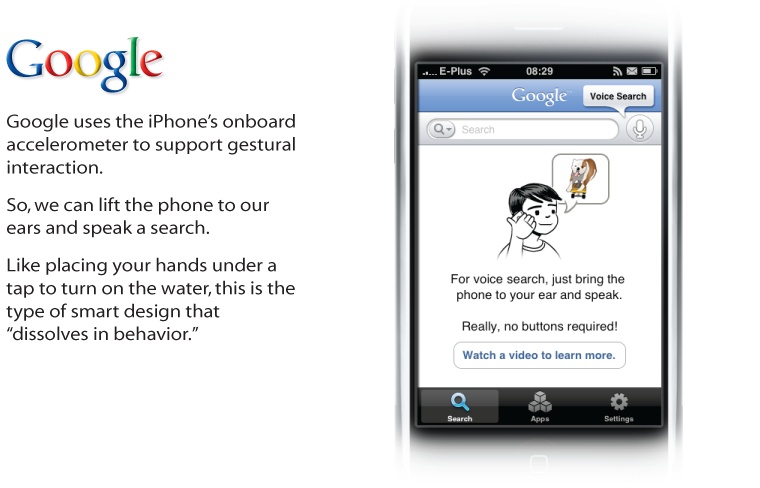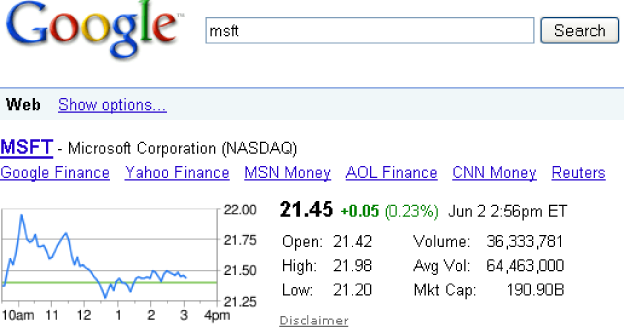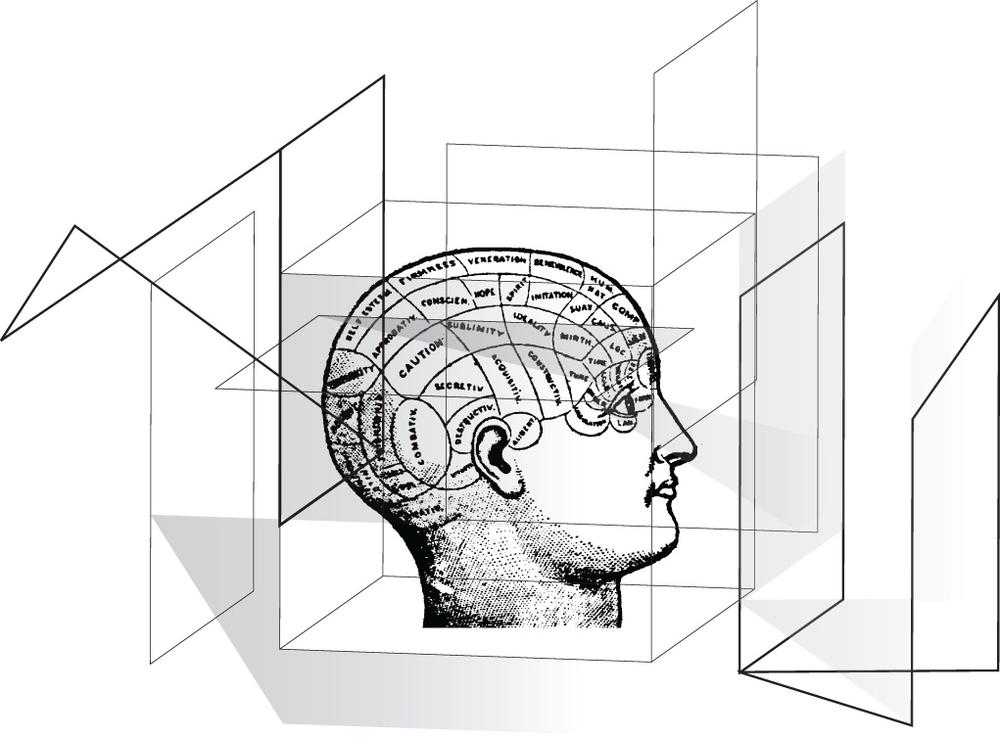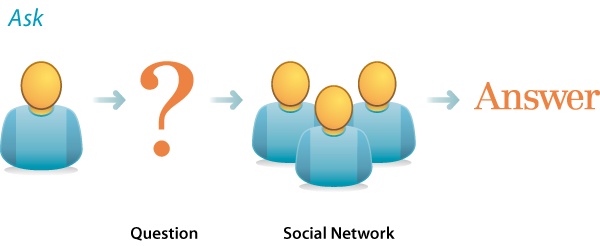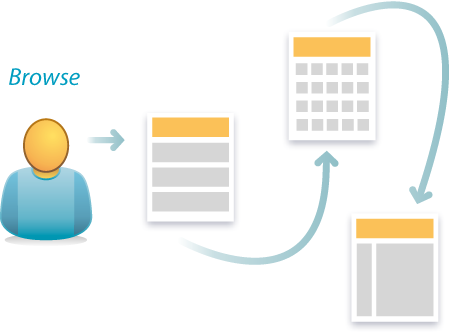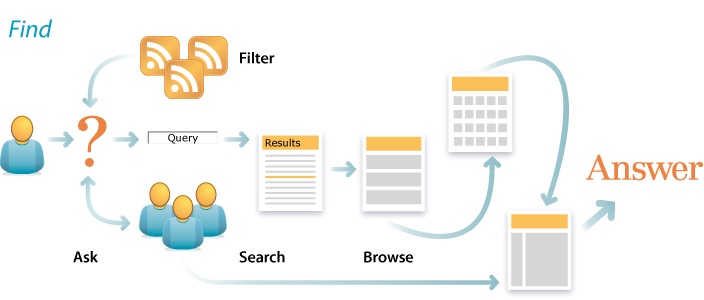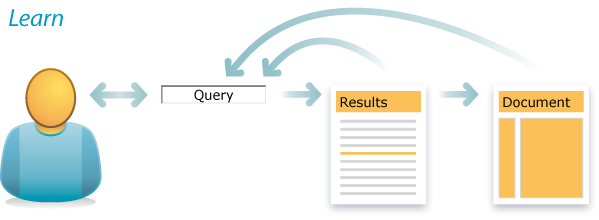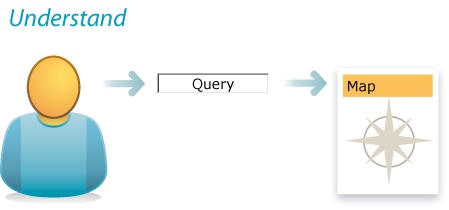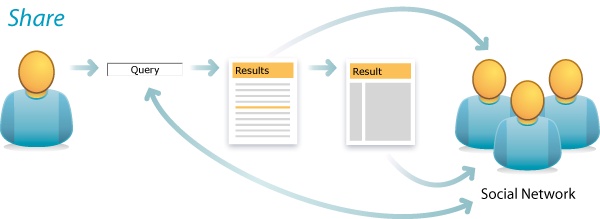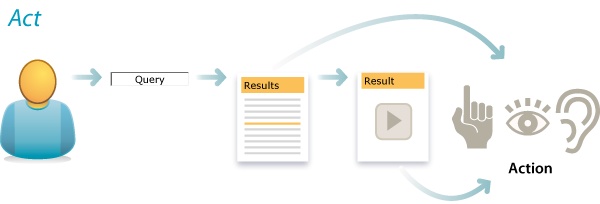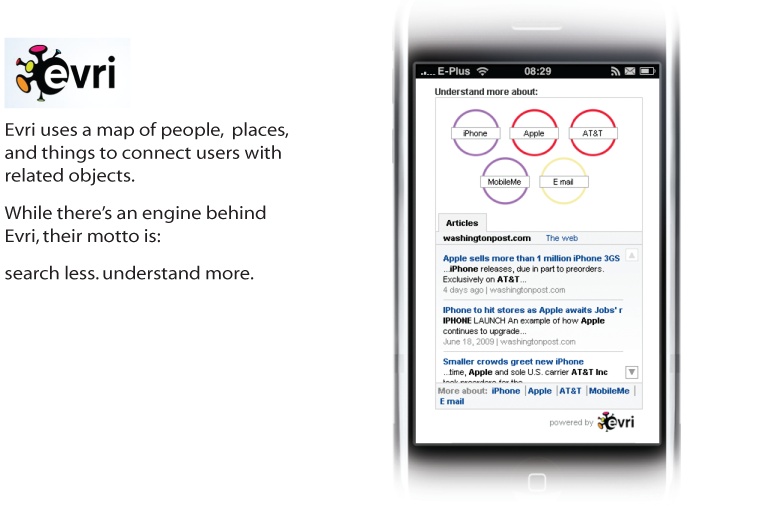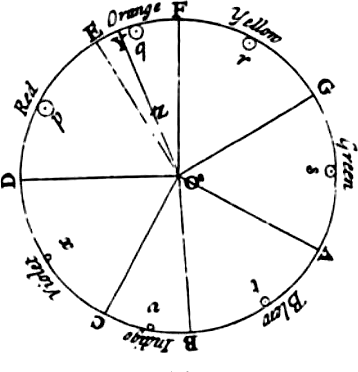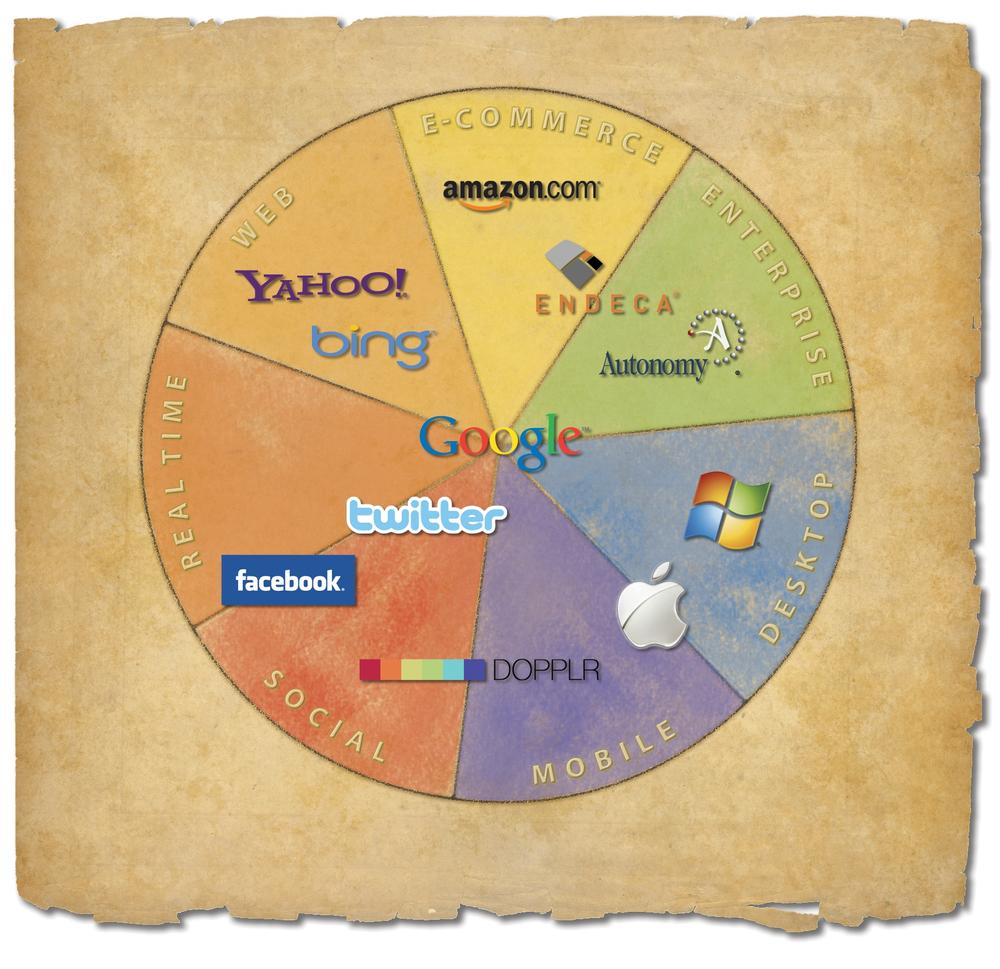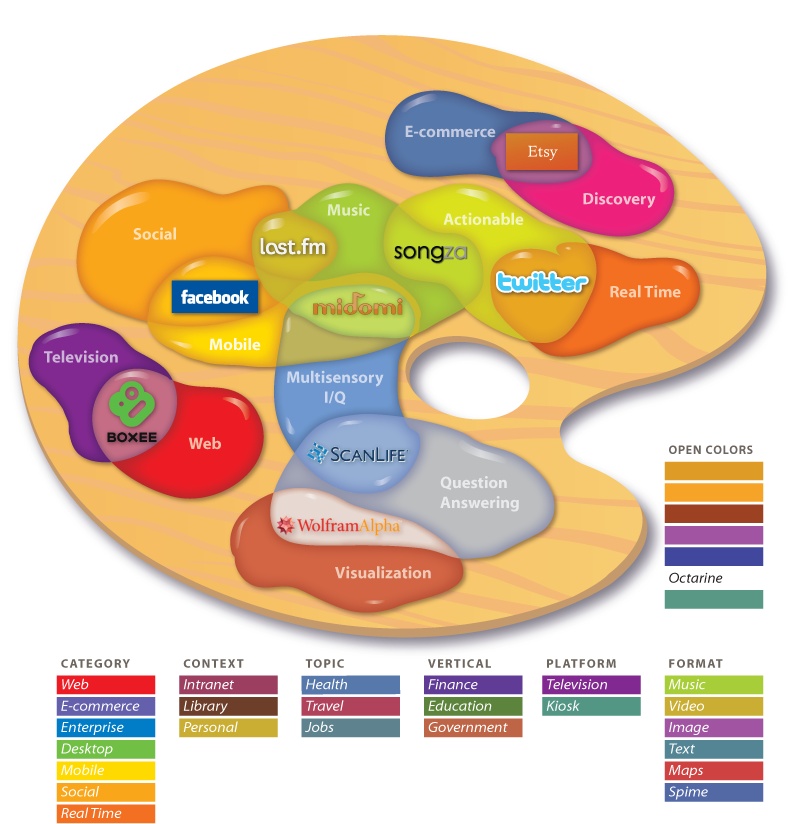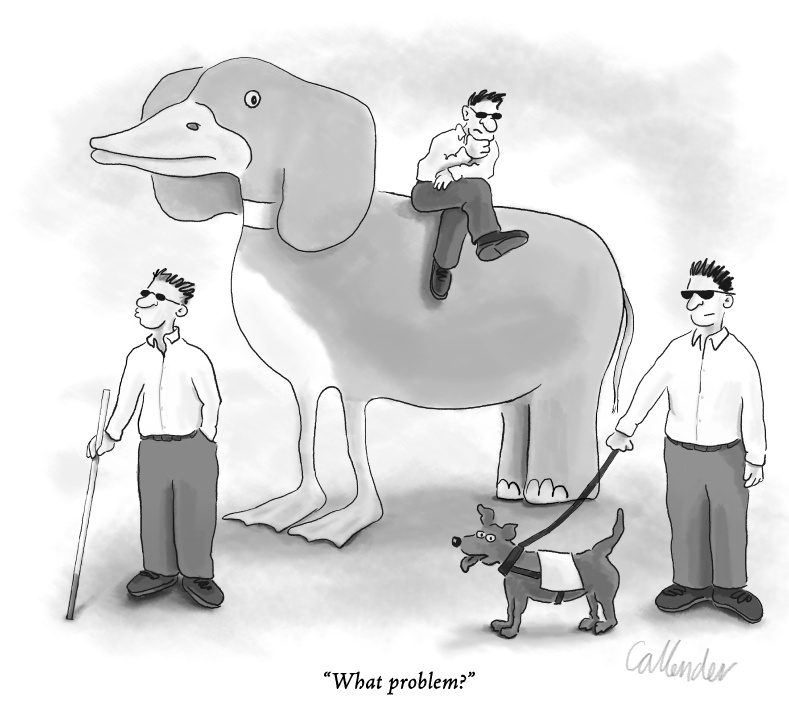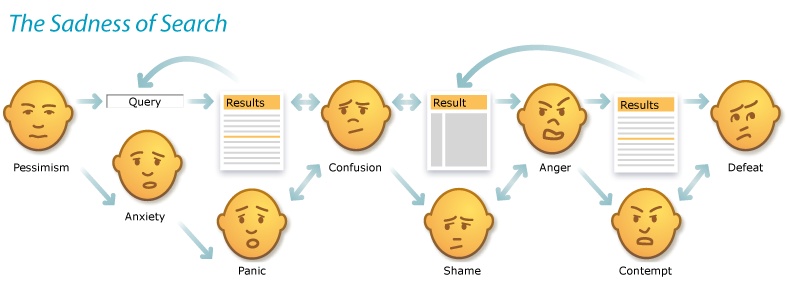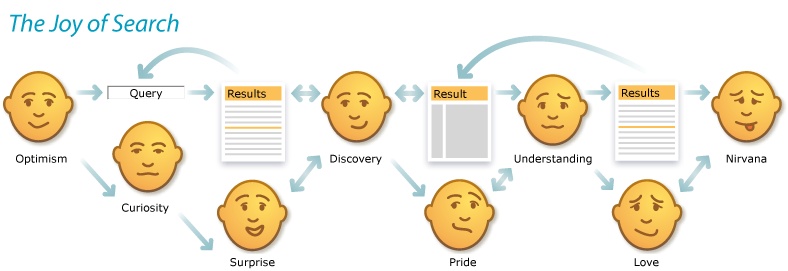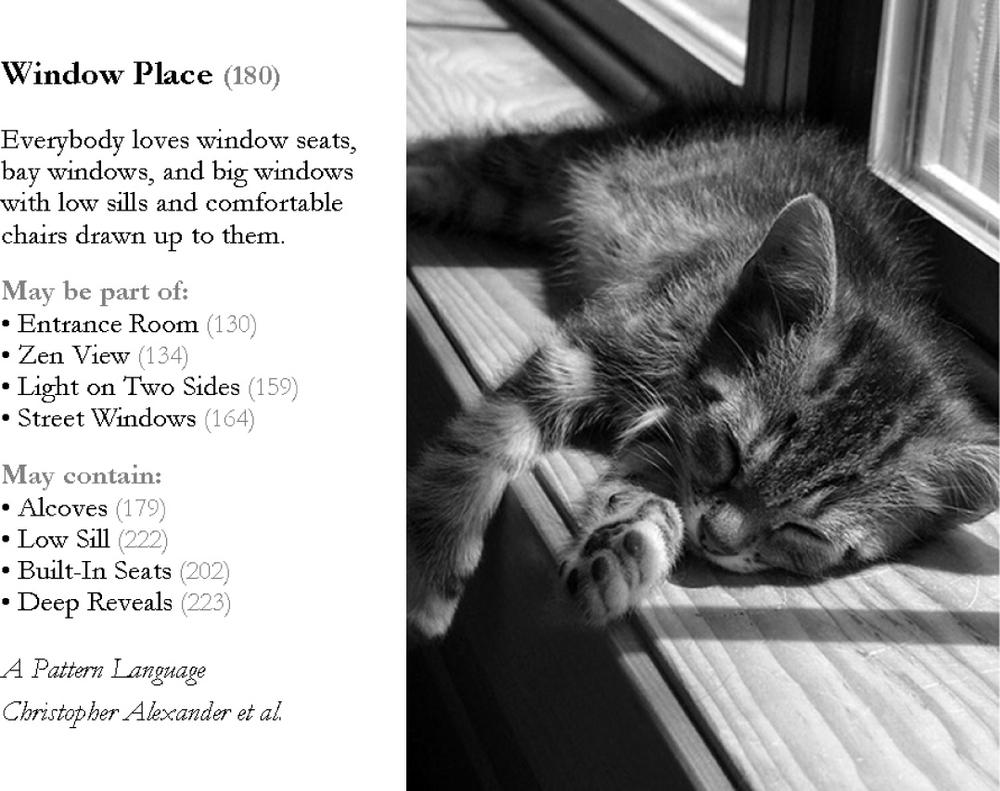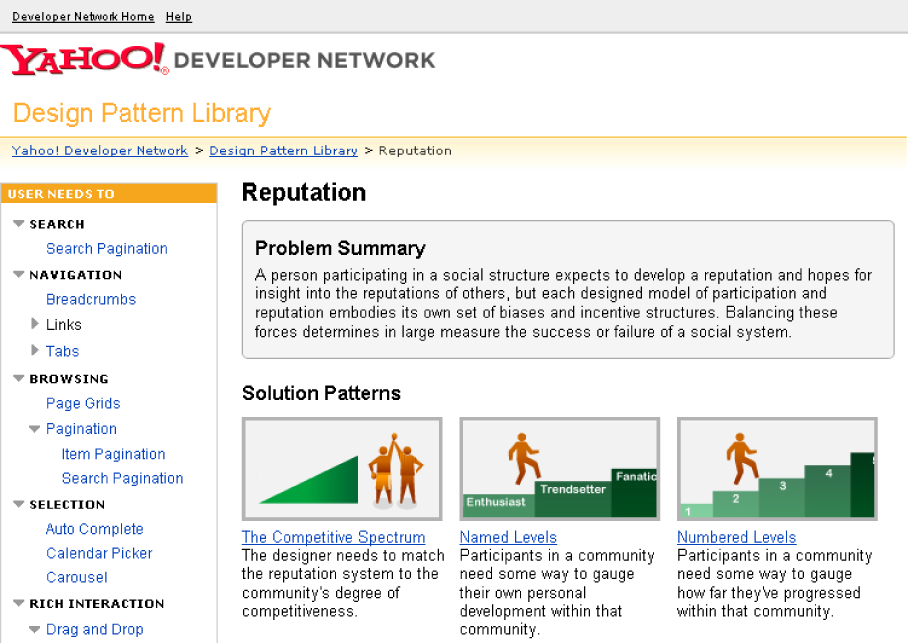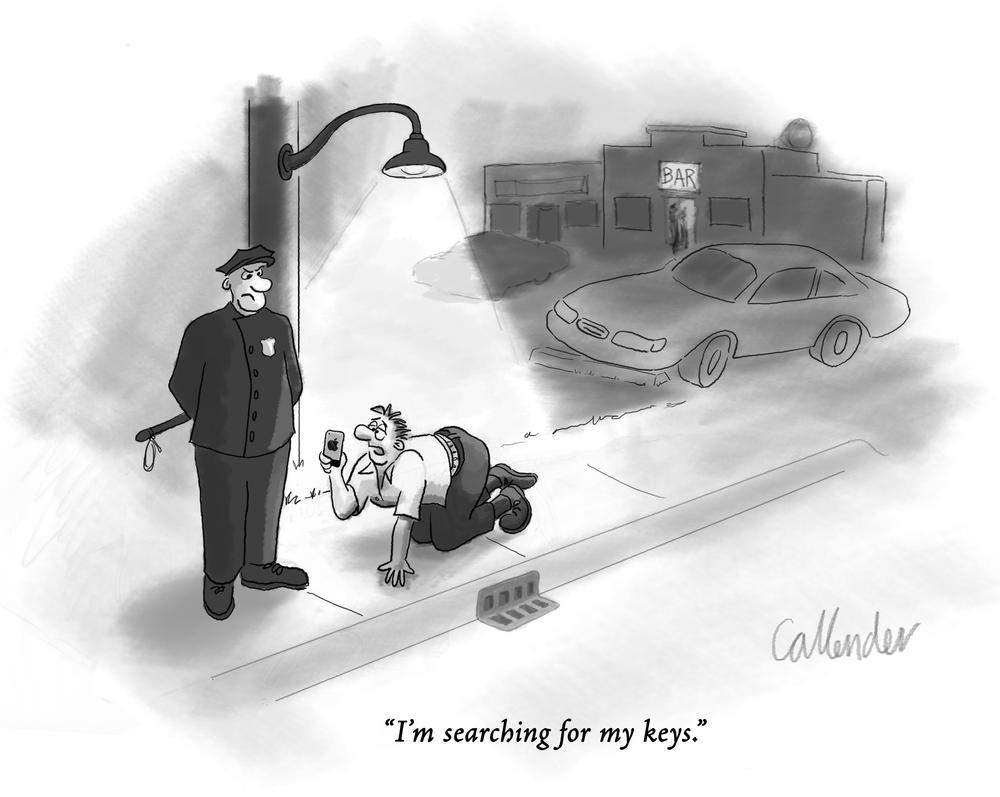Chapter 1. Pattern Recognition
"The future isn’t just unwritten—it’s unsearched“.
In astronomy, averted vision is the art of seeing distant objects by looking to their periphery. It works by shifting responsibility from cones, which sense color and fine detail, to rods, which detect motion and help us to juggle, play chess, and see in the dark. This form of peripheral vision can be practiced. Observers often report a gain of three to four magnitudes. It’s a powerful reminder that sometimes we must look away to see.
This book will test our ability to juggle multiple visions of search and discovery. We will look to the center by describing a pattern language for search that explains user psychology and behavior, embraces emerging technologies and rich interaction models, and illustrates repeatable solutions to common problems. We will explore the edges by studying cool tools that help users ask, browse, learn, share, visualize, and understand.
This juggling act is necessary if we are to pursue both incremental improvement and radical innovation. In today’s world of intense competition and rapid change, both are essential. Search applications demand an obsessive attention to detail. Simple, fast, and relevant don’t come easy. Success requires extraordinary focus in research, design, and engineering, yet you can’t test and tweak your way from Google to Twitter. Time and again, the future of search is invented beyond the borders of its category.
And, search has a future. Search is not a solved problem. Indeed, search is a wicked problem of terrific consequence. As the choice of first resort for many users and tasks, search is a defining element of the user experience. It changes the way we find everything from answers, articles, and advertising to products, people, and places. It shapes how we learn and what we believe. It informs and influences our decisions, and it flows into every nook and cranny. Search thrives within and across myriad contexts and channels. Web, e-commerce, enterprise, desktop, mobile, social, and real time are just a few of its classifications. Search is among the biggest, baddest, most disruptive innovations around. It’s a source of entrepreneurial insight, competitive advantage, and impossible wealth.
Unfortunately, it’s also the source of endless frustration. Search is the worst usability problem on the Web. It’s held that title for many years. We find too many results or too few, and most regular folks don’t know where to search, or how. From enterprise to e-commerce, user needs and business goals are obstructed by failures in findability. And the news doesn’t improve when you change the channel. Mobile search is a mess, kiosks are worse, and interactive television remains the lonely domain of the early adopter. Your average couch potato isn’t quite ready to trade his remote control for a search box.
Of course, pundits claim we’ll solve search soon with artificial intelligence, information visualization, personalization, and the Semantic Web, but this fabled future never arrives. Search remains as noisy and irregular as language and communication. Vendors hawk their wares to IT executives who understand business and technology but turn a blind eye to user experience. Content stakeholders perfect their publishing workflow only to bury their crown jewels behind firewalls and within tightly controlled information silos. Design teams work hard to make search simple, but lack the skills and tools to ensure relevance and speed. Once in a while, the stars do align and real solutions emerge, but in most organizations and applications today, bad search remains an inconvenient truth.
And even when search works well, it can always be improved. Even Google is only good enough until something better comes along. In search, innovation is a forced move. It’s not easy, but it’s not impossible. It is important. And that is the reason for this book. We want to make search better. Or, to be more precise, we want to inspire you to make search better. But first, we had better define what it is that we seek to improve.
Understanding Search
The way we define a problem or frame a question shapes how we and our colleagues understand, answer, and act. An overly narrow formulation leads to tunnel vision, and we’re oblivious to all but the obvious. But stray too far from the center, and we lose our focus while trying to boil the ocean. The best strategy is to avert and revert, juggling ideas, patterns, gaps, and oddballs in the periphery without losing sight of the goal.
The Box
In search, the first ball in the air is a box. It’s the iconic symbol of search and a great place to start. Enter a keyword or two, and you’re good to go.
The box comes in all colors, shapes, and sizes. It sports a variety of buttons and labels. It appears as a feature of sites, browsers, applications, and operating systems, and it’s found across channels and within all forms of interactive media. The box has grown so familiar it now lives in our heads like Plato’s perfect circle. We recognize it as a box, even when it’s not.
Of course, each box has its secrets. How can I search? What’s being searched? Its affordance tells us little about language and scope. Are we querying the text of Twitter or the metadata of music? And can we simply enter keywords or must we speak Boolean? The answers are revealed by context and experience. On Flickr, we know we seek images, but we must learn how and why to query by tag and filter by interestingness.
Similarly, the behavior of each box is revealed only by interaction (or word of mouth). As we begin to type, autocomplete offers to save time and typos, while autosuggest serves up Best Bets and related topics. Or, we can highlight a phrase in Firefox, drag and drop it into the search bar, and query a custom search engine using only our mouse.
iPhone users soon learn the rhythm of tap and type, understanding that the box has become subject to touch. Or we simply raise our phones to our ears and speak our search, relying on Google Mobile to derive what we want from who we are, where we stand, and what we say. No buttons. No typing. No clicks. Our identities, locations, and voices form a new kind of query that has us searching (and thinking) outside the box.
Further reflection is inspired by the interplay between input and output. Often, the results are links and snippets, but sometimes they are answers to questions. If you ask nicely, Google will reply with weather forecasts, stock quotes, traffic maps, and sports scores.
You can track packages, perform calculations, and visualize data. This is where things get interesting. The box isn’t limited to search—it’s also a command-line interface that affords power and flexibility to users in the know. It’s a calculator. It’s a communicator. It’s a universal remote control. The box is a boundary object that links design, engineering, and marketing. We must work together to see what it can do.
The only limit is ourselves. In the prophetic words of William Gibson, “The box was a universe, a poem, frozen on the boundaries of human experience.”[1]
The Goal
Yet, if we keep our eyes on the box, we may lose sight of the goal. After all, search is first and foremost about findability. We search to find objects and answers. We seek to find (and re-find) pages, people, places, products, and facts. The archetypal search is a quick lookup that leads from query to results to found object. It serves as a navigation shortcut that speeds our way from here to there. Search is the means to an end.
Search
Of course, search isn’t the only way we find. We often ask family, friends, and colleagues. Where are my keys? What’s the best way to the market? What’s that URL? Sometimes we ask professionals. Is there a great vegetarian restaurant near the hotel? Can you help me find a good book about global warming? What’s this fungus on my foot?
Ask
Our strategies for asking are often situated by time and place. There are questions at dinner and questions for the doctor. Yet, we increasingly displace these questions by searching for answers in a box. In fact, the line between ask and search is fuzzy, defined mostly by distinctions of syntax and semantics. A query is simply a question without the ornament of natural language. When we ask and search, we seek to find. That is the goal.
Sometimes we don’t need to ask; the answers find us. In our everyday experience, we are inundated by information. News, spam, facts, and gossip flow into our attention through a mesh of channels, networks, subscriptions, and feeds. Our relationships, memberships, identity, and location form an ongoing query against a universal dataset.
Filter
We rely on people, tools, algorithms, and impatience as filters. Still, junk gets in. On the other hand, we often find what we need without leaving the house or lifting a finger.
We also browse to find. We wander aisles, scan shelves, sort papers, open folders, click links, flick photos, and shuffle songs. This takes time and invites serendipity. We never know what we may stumble upon. Browsing evokes a sense of place. There are trails, edges, signs, maps, and landmarks that test our wayfinding skills. As a spatial experience, browsing is unique, and yet many of its most worn paths lead directly to and from search.
Browse
In fact, we move fluidly between modes of ask, browse, filter, and search without noting the shift. We scan feeds, ask questions, browse answers, and search again.
Find
All these modes should be on the table when designing for findability. Each is but one tactic in support of a goal. Rather than prescribing tools and tasks, we must aim for (and beyond) the searchers’ intent. What do they want? What do they need? But, before accepting our mission, it’s worth challenging the objective, because search isn’t only about finding.
As any concierge or librarian will avow, their jobs aren’t simply to answer questions. They first conduct exploratory conversations or reference interviews to better understand what we want and why. A hotel guest who asks for a local area map may be on her way to a restaurant that closed last month. The concierge can identify a suitable alternative and call ahead for reservations. A library patron who wants an old issue of Consumer Reports may be buying a new car, and he may not know the library provides access to an online database of reviews and ratings. The librarian can help jumpstart his search. Oftentimes, due to a gap in knowledge or language, the searcher isn’t able to ask the right question.
That’s why search at its best is a conversation. It’s an iterative, interactive process where we find we learn. The answer changes the question. The process moves the goal. Search has the power to suggest, define, refine, cross-sell, upsell, relate, and educate. In fact, search is already among the most influential ways we learn. It’s trusted and relied upon by millions of people a day. Search is the world’s most popular teacher. As designers, we must expand our vision beyond finding to incorporate learning. And we can’t stop there.
Learn
Search also has the ability to enhance understanding. A search engine results page (SERP) is a custom map that’s built in response to a query. It’s how we see what we’ve found. This potential is best realized in faceted search, where the selective presentation of metadata fields and values serves as a table of contents to the result set. But it’s also evident in the way Google surfaces diverse content types and related queries. And we’re finally starting to see real progress at the intersection of information visualization and search, where rich results can provoke exploration, insight, and understanding.
Understand
Of course, these quests to find, learn, and understand rarely occur in isolation. Search isn’t always a solo sport. We search on behalf of other people. We search with other people. We crowdsearch with Twitter and Mechanical Turk, distributing our queries (as whispers or shouts) to a networked community of searchers and solvers. Search can be a social experience in which we share goals, queries, and results. As designers, we must strive to support collaborative discovery. We must help people to search together.
Share
The goals of users may warrant other acts. While print, save, and share are most common, a variety of tasks may be integral to the process. Increasingly, on result pages, we can play music, watch videos, buy products, update calendars, and call contacts.
Act
The promise is particularly rich in mobile, but each channel offers unique possibilities for integrating useful features into actionable results. Search is not just about findability. We search to learn, understand, share, and act. As designers, when we focus on goals, the challenge becomes exhilarating (and scary), because the end of search is a moving target.
The Engine
A more traditional way to define search is by its software. Buy the engine, then figure out what it’s good for. This can put search in a straightjacket. How often have we been told the engine can’t handle that content type or index multiple sites or rank by popularity or respond in less than a lifetime? So search fails because all too often, if it’s not easy, it’s not possible. When technology precedes requirements, the user experience suffers.
This approach also leads to solutions in search of problems. Remember when relevance scores were all the rage? Your first result is 78% relevant. What the heck did that mean? Why did companies clutter their results with useless trivia? Because it was a default. The engine made it easy. Similarly, most natural-language interfaces, flashy result visualizations, and autocategorizers are simply high-tech hammers in search of nails.
Then again, hammers do have their uses. A tool in the hand is worth two in the box. Hammers extend our reach and amplify force. They push buttons and break down doors. Similarly, engines can do more than search. For instance, there’s an engine called Evri, shown in Figure 1-18, that appears in the Washington Post’s website. At the end of each article, readers can learn more about relevant people, organizations, and topics.
Using Evri, readers don’t search, they simply follow a link. But search is the engine that powers this experience. The same is true on e-commerce sites where most links are queries against the product catalog and the analytics database. Even when we browse, we search.
This reframing of search has produced a whole new generation of discovery tools and recommender systems. Last.fm, Pandora, Ambiently, and StumbleUpon are search without the box. We click, jump, and vote. Keywords are displaced by hearts and thumbs.
We also open the door to innovation by sharing the search API. The New York Times, for instance, allows third parties to create tools for exploring its database. With over 13 million articles, 35 fields per article, and support for faceted search, this is an amazing playground for developers to build anything from custom link lists and remote search widgets to complex visualizations. New applications can expand their audience and clever mashups can expand their minds by showing how news can be reimagined.
In search, innovation through collaboration is smart strategy. Emerging technologies from disparate categories can suddenly inject search with new possibility. For instance, in the subset of machine learning known as pattern recognition, our devices are learning to recognize and analyze faces, footfalls, gunshots, speech, text, images, and data. Sensors and algorithms combine to detect threats, track trends, and identify anomalies. And software agents tell us what topics to search. It’s truly difficult for us humans to stay current, so we need to keep many eyeballs on the engine without losing sight of the goal.
The Discovery of Color
The spectral colors of red, orange, yellow, green, blue, indigo, and violet are produced by light of a single wavelength, and are all visible to the human eye, except for indigo, which most people can’t distinguish. Isaac Newton included indigo so the number of colors would match the number of known planets, notes in a major scale, and days in a week. Of course, any list of colors is arbitrary in a spectrum of infinite variation. Colors are categories we use to explain what we see and, in the case of ultraviolet and infrared, what we don’t. We even have imaginary colors like octarine, the eighth color, an elusive spectral mix that’s hard to describe and impossible to perceive. That’s the thing about color. Try describing a rainbow or a sunset to a blind person or ask a synesthete to tell you about the sound of blue or the color of Monday.[2] Most of us are unable to fully accept or appreciate this cross-sensory perception. We have to see to believe.
The same holds true in search. We have a number of well-established categories: web, e-commerce, enterprise, desktop, mobile, social, and real time. Within each category, we embrace a set of proven technologies, business models, user behaviors, and best practices. We are mostly blind to the chaotic yet colorful array of search startups and design patterns dancing on the horizon. There are so many possible futures for search and discovery, and it’s hard to discern good ideas from bad. In the 1990s, folks laughed at a startup named GoTo and the absurd idea of paid search. Meanwhile, people raved about PointCast. Push was the next big thing. Until it wasn’t. We’ve made many mistakes and it’s tempting to give up. Why engage a future so unevenly distributed? It’s safe to be a skeptic, so we stay within our category and copy the competition. We test and refine, we celebrate incremental improvement, and we laugh at the latest big idea for reinventing search. “What a joke! That’ll never work.” Again, we have to see to believe.
Inevitably, this insularity leads to a category error. We omit a key feature because “that won’t fly in the enterprise.” We miss the next Twitter because “that’s not search.” This is why it’s so important to look beyond our borders. The enterprise can learn from e-commerce. We must simply adjust for different constraints, metrics, and goals. It’s equally vital to reorganize. Like colors, our categories are arbitrary by nature. We organize to understand, and we must reorganize to see anew.
For instance, there’s clear value in naming the primary colors of search. This classification provides a quick way to reference the major categories and key players. It helps us explain the market dynamics and business strategies behind divergent search solutions. And, as the color wheel illustrates beautifully, it offers a glimpse of the brilliant diversity of search.
This is not a pure organization. On the contrary, it’s a loose grab bag of context, purpose, and platform. Yet it still belies the true chaos of the marketplace for discovery. We Yahoo! on the iPhone and use Google Desktop to query web history. We search social conversations threaded over applications, channels, languages, and time zones for embedded links that connect to any media. Search won’t fit cleanly on a color wheel. In fact, these categories reveal more about the history of search than its future.
Today, search is best imagined as an artist’s palette, as shown in Figure 1-21. The mixing of colors has begun. Lovely hues and shades exist outside the categories. We can see them better when we shuffle our ways of organizing. For instance, there are riches within the niches of format.
In images, we find the photo facets of Getty, the interestingness of Flickr, and the visual recognition of Like.com, which lets us search and shop by color, shape, and pattern.
In music, Songza turns the results interface into a jukebox, Midomi lets us search by singing, and Last.fm spins our personal channel into a melody of social discovery.
In video, Everyzing unlocks the vault with its speech-to-text translation technology, while NetFlix, Hulu, and Boxee search together and apart for the future and end of TV.
We can also organize by subject and industry, taking a close look at search verticals like health, travel, and real estate. Or we can sort by approach, focusing on text analytics, clustering, question answering, personalization, visualization, or rich results. Each organizational scheme adds combinatorial possibilities to our palette. Desktop search is social and personal. It’s not about the desktop. Music is mobile. There’s video in every vertical. The potential for cross-fertilization is huge. Diversity is the inexorable result of search.
As designers, we can learn from each color and combination. Many ideas work once, or never, but there are patterns of behavior and design that bridge contexts. In this book, that’s our target: we will aim to explore core concepts and best practices by studying examples drawn from within and between contexts. And we will repeatedly try to escape the category. What kinds of information and objects are unsearchable? What, if anything, will never be subject to search? What can we learn from asking, browsing, and filtering? Where is the boundary between search and unsearch? To think outside the box, we will search beyond the periphery. Sometimes we must look away to see.
Elephant in the Room
Of course, whether it’s a wretched beggar on the sidewalk or a pink elephant on the dinner table, sometimes we look away to ignore. We avoid taboo topics and inconvenient truths by focusing on small distractions. It’s a tactic that’s at home in the kitchen and the corner office. And it’s often at work in IT, where search is an elephant we prefer to duck.
Let’s face it: search is a wicked problem with no definitive formulation, considerable uncertainty, and complex interdependencies. Stakeholders have divergent goals and radically different world views. Requirements are incomplete, contradictory, and ever-changing. Search is both a project and a process. It’s a problem that’s never solved.
And that’s not the half of it. Our organizations are woefully unprepared to tackle search. We lack the team and the technology. Unlike Google, most firms aren’t structured to manage the high-tech, step-changing, cross-functional, user-centered challenge. There are too many hyphens. As a hybrid of engineering, marketing, and design, search creates too many openings for missing links. As a complex adaptive system that’s sensitive to scale, search is a mystery that morphs over time. Search isn’t just wicked, it’s downright dangerous. Why risk your career (and your weekends) on a problem that’s so intractable?
Especially when it’s also invisible. That’s right. Search is an elephant that hides in plain sight because executives lack the right radar. Many in management don’t realize the role search plays in defining the user experience. They fixate on the home page, they fuss about look and feel, and they care about the content. They may even fume about findability, but they are easily distracted or misled because they really don’t understand search.
So, it’s safest to keep search small. Buy a brand, defer to defaults, don’t ask questions, maintain plausible deniability, and be ready with a response. The speed is subject to security. We had to choose fast or safe. It’s too hard to make it easy. We can’t afford the cost. The results are relevant in theory. Our problem is the users. They use the wrong keywords. But, it’s not worth much attention, because our users mostly don’t search.
We underfund and understaff search, and its poverty becomes a self-fulfilling prophecy. In many contexts, expectations have been crushed. Users don’t search now since search failed then. Sometimes they browse. Often they bail. They abandon online for phone and email. This regress to more costly channels is bad for business. It’s also sad for society.
The Sadness of Search
The Sadness of Search
Every increase in search costs diminishes our quality of life. Poor search wastes time like a crooked street sign that sends us in the wrong direction. It erodes trust, derails learning, and confuses decisions. It makes us blame ourselves. And therein lies the problem. For most people, search is sufficiently advanced technology that it’s indistinguishable from magic. We don’t know what to expect or who to blame. We certainly can’t see what’s missing. Our response can be emotional. We suffer. We feel sadness, shame, anger, and disgust. Sometimes we soldier on, unhappy but resolute. Often we surrender. We simply fail to search. We live uninformed without seeing what we miss, for the cost of the unsearched is an unseen drag on commerce and culture, as invisible as it is incalculable.
The Joy of Search
It doesn’t have to be this way. When we design with our users in mind, search can be an engine of inspiration and joy. We find what we want. We discover what we need. We stimulate our minds and recover our memories. We feel surprise, wonder, amusement, and pride. Search is a core life activity that engages both intellect and emotion. It has the power to change a life or save a business. For designers, search is a grand challenge, an elephant we should not duck. We can succeed at search. We just need courage and vision.
A Mapmaker’s Manifesto
In this book, our taste for rhetoric and imagery may run amok. Adding color to the message can occasionally obscure its meaning. That is not our intent. So, for the sake of clarity, here are our beliefs and principles in plain language:
Search is a problem too big to ignore.
Size matters. Linear growth compels a step change in design.
Simple, fast, and relevant are table stakes.
One size won’t fit all. Search must adapt to context.
Search is iterative, interactive, social, and multisensory.
Increments aren’t enough. Even Google must innovate or die.
It’s not just about findability. It’s not just about the Web.
The challenge is radically multidisciplinary.
We must engage engineers and executives in design.
We can learn from the past. Library science is still relevant.
We can learn from behavior. Interaction design affords actionable results.
We can learn from one user. Analytics is enriched by ethnography.
Some patterns, we should break like a bad habit.
Search is a complex adaptive system.
Emergence, cocreation, and self-organization are in play.
To discover the seeds of change, go outside.
In science, fiction, and search, the map invents the territory.
The future isn’t just unwritten—it’s unsearched.
OK, so a rhetorical flourish or two infiltrated our manifesto. What can we say? They’re sneaky little buggers! But our aim is clear. We are passionate about search. We believe it’s far more interesting and important than most people realize. We aspire to get the design right and the right design through refinement and reinvention. We don’t have all the answers. Neither do you. But as writers and designers, we are inventing the future of experience and discovery. We are the mapmakers. Together, we can make search better.
Apophenia Redux
In Pattern Recognition, William Gibson defined apophenia as “the spontaneous perception of connections and meaningfulness in unrelated things.”[3] It’s an old term, coined by a psychologist in 1958, that enjoys new life in our fast, flat world. Apophenia is a type-1 error, a false positive caused by excess sensitivity. Most neurologists agree this condition exists in everyone. It’s a natural bias of the human mind. We search for patterns to explain and anticipate change. On occasion, we see a new trend. Invariably, we confuse signal for noise. Apophenia is a symptom of madness and creativity. When artists, entrepreneurs, and autistic savants spot new patterns in music and markets, they walk the fine line between crazy and genius. It’s a line we should all walk more.
Of course, there’s value to be had in mining old patterns, as the architect Christopher Alexander eloquently intimated in The Timeless Way of Building:
"There is one timeless way of building.
It is thousands of years old, and the same today as it has always been.
The great traditional buildings of the past, the villages and tents and temples in which man feels at home, have always been made by people who were very close to the center of this way.”[4]
In his quest for “the quality without a name,” Alexander developed a practical way to catalog patterns of behavior and design. His pattern language offered a structured method for identifying and illustrating repeatable (optimal) solutions to common problems.
This framework has been embraced in a variety of fields from ecology and education to engineering and design. Recently, we’ve enjoyed access to pattern libraries that help us create more useful, usable, and desirable software and interfaces. Yahoo!, in particular, has done a brilliant job of sharing patterns and code with the wider community (Figure 1-26).
Patterns embed wisdom, yet we should mind whose patterns we trust. Not all are created equal. To design well, we must understand how patterns fit together and relate to a context of use. A pattern in one scene is a problem in the next. If we aspire to innovate, we must dare to break the mold. Nobody said the timeless way was easy.
"We are searching for some kind of harmony between two intangibles: a form which we have not yet designed and a context which we cannot properly describe.”[5]
In this task, past performance may impede future results. Therein lies the paradox of prediction. We must look back to see ahead, but as Mark Twain noted, “History doesn’t repeat itself—at best it sometimes rhymes.” To envision the next stanza, we might take a page from e.e. cummings, the mud-luscious poet of unconventional syntax:
"Understand the rules. Then, break them with intent.”
That’s the problem with the future of search. The prophets don’t understand. Neither do the investors, executives, and journalists who swallow their sermons whole. Often, they don’t know how search works. They rarely grok the complexity of software development, and they certainly don’t understand how user psychology and behavior are related to the success or failure of search applications. So, apophenia runs rampant. It’s hard to keep track of all the paradigm shifts and Google killers, especially when they fail so fast. Ironically, spin notwithstanding, the official future of search—artificial intelligence with a dash of information visualization—hasn’t changed in decades. Most search startups just add new wrinkles to an old face. We’re stuck on the original Star Trek, seeking technological singularity and the agents of tomorrow in a rusty rearview mirror. It’s like the signs outside British pubs that promise “Free Beer Tomorrow” forever.
There is a way to break the stalemate. We can unlock the game of improve versus innovate. We can forsake the tyranny of the OR for the genius of the AND.[6] The key is vision. We must focus on the fine detail of stable patterns at the center, while keeping an eye on emerging technologies at the periphery. We must know what we see and where to look.
That’s the aim of this book. It’s a lens for refraction and reflection. It’s a microscope, a telescope, and a kaleidoscope. By studying patterns and surveying trends, we will learn to improve and innovate. And by adding to our tools and palette, we will make search more visible and vibrant for ourselves and for those without vision. This book is a practical guide to the future, a colorful map to frameshift, and a doorstop to boot. We wrote it because the box is reshaping the globe right now. It’s a topic both timely and timeless. Search is a core life activity, as ancient in its form as the trees and hills, and as our faces are. We must discover its patterns and break them with intent. Let’s get cracking!
[1] Count Zero, William Gibson (Ace).
[2] Synesthesia is a neurological phenomenon in which stimulation of one sensory or cognitive pathway leads to automatic, involuntary experiences in a second pathway, as when the hearing of a sound produces the visualization of a color. People who report such experiences are known as synesthetes.
[3] Pattern Recognition, William Gibson (Penguin).
[4] The Timeless Way of Building, Christopher Alexander (Oxford University Press).
[5] Notes on the Synthesis of Form, Christopher Alexander (Harvard University Press).
[6] Built to Last, Jim Collins and Jerry Porras (Harper).
Get Search Patterns now with the O’Reilly learning platform.
O’Reilly members experience books, live events, courses curated by job role, and more from O’Reilly and nearly 200 top publishers.
